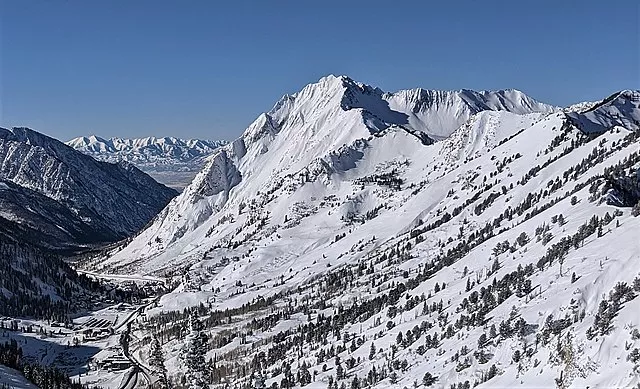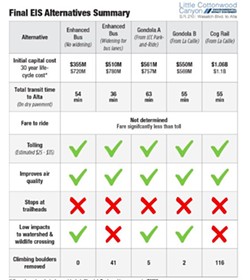
- Wikimedia
- The mouth of Little Cottonwood Canyon, where state transportation officials plan to construct a roughly $500 million gondola to the Alta and Brighton ski resorts.
Utah's Little Cottonwood Canyon is a state treasure, beloved and sought out by skiers, mountain bikers, rock climbers, hikers, leaf peepers, bird watchers and much, much more.
But it was only that first category of canyon visitor on the minds of the Utah Department of Transportation when it issued its recommendations for the construction of a half-billion-dollar gondola project that will move people from a parking lot exclusively to two private ski resorts, according to a UDOT spokesman.
"The main concern with mobility is that during the winter, resort-bound skiers arrive during the same peak travel period in the morning," UDOT's Mitchell Shaw said in a prepared statement. "By reducing use of vehicles by the main users—resort skiers—the recreation users who want to travel to the trailheads should have improved mobility on S.R. 210."
While Shaw is correct that pulling any drivers off the road is better for all the drivers left on the road, he went on to explain that any secondary benefit from gifting a gondola to skiers is intended to be enjoyed by drivers and drivers alone. Because not only would the gondola skip lower-canyon destinations, UDOT believes that any transit service to those areas—including as low-impact as a humble bus stop—would impede the ability of skiers to reach the resorts as quickly as possible.
"Additional bus stops in the canyon would also add travel time for all travelers on the bus, making transit a less-attractive option for the majority of users," Shaw said. "During the summer, [car] traffic is better dispersed throughout the day, so there is not a peak mobility concern that would warrant summer bus service in Little Cottonwood Canyon, including service to trailheads."
Shaw's comments would seem to confirm the criticisms of gondola opponents, who object to such a large sum of taxpayer dollars being directed toward a project with so limited public benefit. Despite the opportunity to move toward a holistic, year-round, multi-modal transportation corridor serving all users, UDOT's plans explicitly double-down on car-centrism and disregard the potential for car-free travelers entirely.
On its website, the anti-gondola group Save Our Canyons argues that rather than solving traffic congestion, UDOT's plans will threaten critical watershed areas while limiting canyon access for non-resort users.
"We support lower-cost solutions that utilize our existing infrastructure, such as carpool incentives ... year-round enhanced bus service with stops at multiple locations and more frequent service at peak times, enforcement of the traction law, and mandatory parking reservations at ski resorts," it states.

- Utah Department of Transportation
- In a summary of its transportation alternatives, UDOT claims that trailheads in the lower section of Little Cottonwood Canyon would not be serviced by bus, train or gondola.
Materials released by UDOT as part of its environmental impact study suggested that lower-canyon transit stops would not be possible regardless of what is built, whether that be a gondola, a cog rail line or bus rapid transit (BRT). But Shaw explained that is largely a reflection of preference, not policy, as UDOT doesn't see its role as facilitating canyon transportation outside of cars, which are currently allowed to be driven to and parked at many trailhead-adjacent areas.
"UDOT is not responsible for increasing use at the trailheads or at dispersed recreation sites, but for improving mobility on S.R. 210," he said. "In the future, if the USDA Forest Service identifies a need to increase transit service at the trailheads, it can work with UTA to implement it."
In a follow-up phone interview, Shaw and Josh Van Jura—the UDOT project manager over the gondola—reiterated that the Utah Transit Authority and the Forest Service are free to explore changes to lower-canyon access. And while UDOT engaged in some discussion around the subject with the Forest Service, they said, the department did not pursue transportation options beyond the resorts, seeing skier access and the car traffic it causes as the sole problem to be addressed under the current project.
They did note that cyclists and pedestrians are free to travel up the canyon on their own power, but emphasized that non-car transportation on Highway 210 is not a Department of Transportation concern.
"They aren’t within the problem and the purpose and need statement," Van Jura said.
In recent months, UDOT representatives have testified at Salt Lake City Council meetings and state legislative committee hearings, where they've suggested that the departments priorities are shifting from a car-exclusive agency to one that supports active and public transportation. But that talk has yet to materially translate into UDOT's plans and construction projects, which give non-car users as little space as possible, if any space at all.
Lawmakers, however, are increasingly focusing on the need for transportation options and multi-modal infrastructure. A $45 million fund for the buildout of a statewide trails network (to be overseen by UDOT) was approved this year, along with $200 million to build a new FrontRunner station in Draper and to expand the double-tracked portions of that line.
Those figures suggest that for the cost of a gondola to the ski resorts, Utah could instead expand its passenger rail network by roughly three stations, bolstering connections for the entire transit network (a cog rail line up the canyon could also pull double-duty as a year-round transit connection for the southeast corner of Salt Lake County).
The Link LonkApril 01, 2023 at 03:41AM
https://news.google.com/rss/articles/CBMikAFodHRwczovL3d3dy5jaXR5d2Vla2x5Lm5ldC91dGFoL3Vkb3Qtc3Bva2VzbWFuLXNheXMtbGl0dGxlLWNvdHRvbndvb2QtY2FueW9uLWdvbmRvbGEtcGxhbi1pbnRlbnRpb25hbGx5LWlnbm9yZWQtbm9uLXNraWllcnMvQ29udGVudD9vaWQ9MTk3NjM0MDfSAZ8BaHR0cHM6Ly93d3cuY2l0eXdlZWtseS5uZXQvdXRhaC91ZG90LXNwb2tlc21hbi1zYXlzLWxpdHRsZS1jb3R0b253b29kLWNhbnlvbi1nb25kb2xhLXBsYW4taW50ZW50aW9uYWxseS1pZ25vcmVkLW5vbi1za2lpZXJzL0NvbnRlbnQ_b2lkPTE5NzYzNDA3Jm1lZGlhPUFNUCtIVE1M?oc=5
UDOT spokesman says Little Cottonwood Canyon gondola plan intentionally ignored non-skiers and non-drivers - Salt Lake City Weekly
https://news.google.com/search?q=little&hl=en-US&gl=US&ceid=US:en

No comments:
Post a Comment